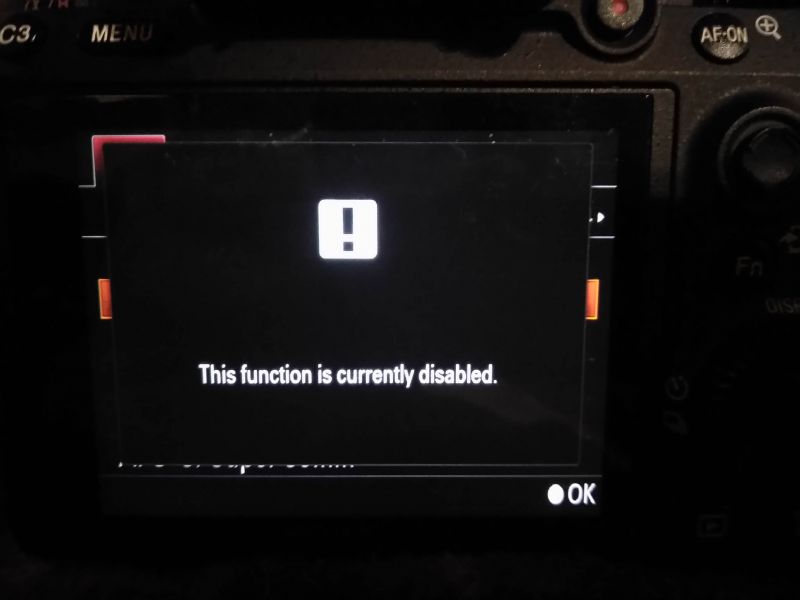
Hey Sony, Canon, and Nikon! You’re about to race each other to the patent office. Get ready!
What I’m about to describe is something I haven’t seen yet in any of the exciting current-generation mirrorless systems, so I’m here to fire the starting pistol. Actually, let’s be honest: I’m here to beg.

[Related Reading: Click here to read my Canon EOS R review!
[Related Reading: Click here to read Pye’s 6-month Canon EOS R review!

[Related Reading: Click here to read Our review of the Sony A7R3!

[Related Reading: Click here to read OUr review of the Nikon Z7!
Before we dive in, a disclaimer: I really do love mirrorless cameras, and I’m ready to let go of my DSLRs. Having said that, all three of the major full-frame mirrorless systems could really use these subtle improvements, in order to make mirrorless cameras (their viewfinders) to feel more like the professional SLRs that many photographers are used to.
[Related Reading: How Canon Is Going To (Eventually) Take Back The Mirrorless Market]
If you think these ideas are unnecessary, that’s OK, but it wouldn’t hurt to at least have them as options, right?
If you think these ideas are genius, please share this article so that hopefully some engineers at Canon/Nikon/Sony catch wind of them! Thanks in advance…

Mirrorless Cameras Still Don’t Operate Like DSLRs, But They Could
Many photographers’ first cameras were SLRs or DSLRs. The optical viewfinder still has many advantages, too: it just works, it’s always there, ready to help you click a photo the instant you turn the camera on. In fact, even with the camera off you can raise it to your eye and frame your shot and (roughly) achieve focus! Plus, you’re always seeing the real world, in real-time. But I digress.
Part of why many pros prefer optical SLR viewfinders is definitely their dependability; their very nature offers an interface with the subject that electronic viewfinders can’t truly match.
 Sony A9, Canon EOS R, Nikon Z7
Sony A9, Canon EOS R, Nikon Z7
However, electronic viewfinders have definitely been getting so high-res that they look truly real, (the EOS R’s viewfinder is gorgeous!) and can have nearly zero lag and/or a fantastic framerate. (The Sony A9 viewfinder is definitely ready for most all types of action sports, and it’s only going to get better with its eventual successor!)
Unfortunately, they’ve focused so much on these impressive, exciting specs that it almost feels to me like they’ve forgotten one thing that makes optical viewfinders so reliable. Here they are:
 Unfortunately, all mirrorless camera viewfinders have a sensor that usually turns the viewfinder off if it’s not actively raised to your eye.
Unfortunately, all mirrorless camera viewfinders have a sensor that usually turns the viewfinder off if it’s not actively raised to your eye.
(In other words, the above feature isn’t very useful, but it could be…)
The (almost) Always-On Viewfinder
First, here’s the craziest idea:
Like optical viewfinders, I wish electronic viewfinders could be more ready to shoot, more often. Would it be too much to ask to just have the EVF stay on the whole time the camera is on? Or at the very least, allow me to designate an auto-shutoff delay? There’s already a menu page for “Power Off Delay” (on Nikon, see above) …so why not let me leave the EVF for an extra few seconds as I pull the camera away from my face? (Would it be too much processing power to play live view on both the rear LCD and the EVF for just a few seconds?)
Yes, it would consume battery power like crazy to have the viewfinder on all the time, but battery technology is getting better, and EVF power consumption is getting much more efficient. It wouldn’t be too bad to at least have the EVF stay on for a few extra seconds here and there.
In fact, as a working pro who shoots 12-15+ hour long weddings, I’m already in the habit of turning my camera off whenever it’s hanging from my hip (Spider Holster!) and not raised to my eye.
As I said, that’s the crazy idea. There are two other crucial issues that harm my ability to get a shot, and I think many will agree that they could use a rethink and/or redesign. Let’s talk about those next!
 …Well, that’s VERY helpful! Thanks for the in-depth report! (Sony A9)
…Well, that’s VERY helpful! Thanks for the in-depth report! (Sony A9)
Never Stop Me From Shooting With A Warning Message!
One thing that has been infuriating about working with the otherwise incredible current-generation Sony (and Nikon, and Canon, in decreasing order of frequency) mirrorless camera bodies has been the various warning messages that can pop up in the viewfinder. They tell me things like, “This option is not available at current settings or in the camera’s current state” …or things like that.
 OK, thanks for at least letting me know which setting to change! (Nikon Z7)
OK, thanks for at least letting me know which setting to change! (Nikon Z7)
 …Hey! What Happened to that extra info? #CrypticMessage! (Nikon Z7)
…Hey! What Happened to that extra info? #CrypticMessage! (Nikon Z7)
What the…? Do you think I have the time to read that long of a message while I’m actively trying to shoot? Some functions (such as Focus shift for nature and landscapes) might be slow-paced shooting conditions, but in other situations, I might actually miss a critical moment, while either reading this message or trying to hunt down which setting/state is hampering me.
At the very least, I want to always get a more detailed message about which setting we need to change? It’s obviously possible, as seen in the previous, less cryptic screenshot. Honestly though, if I’m actively trying to shoot, I’ve really only got time for two or three words, like “BUFFER CLEARING” or “CHANGE AF MODE”. That’s it. Keep it simple, and keep it off in the corner of the viewfinder if I’m actively shooting.
Sony is indeed the worst culprit in this regard, for example, if you try to do something like switch into “Super-35” (APS-C crop) mode while the buffer is clearing. In this situation, you could actually miss a moment.
Bottom line: any error message should never block more than a small corner of the live view, and cryptic “Function Unavailable” messages are extremely frustrating.

Image Review/Playback Always On The Rear LCD Only
Here’s the last request I have, for those of us who are still used to reviewing images on our rear LCD, and would like the viewfinder to remain in its “ready-to-shoot” state all the time:
How many of you leave auto image review on, and how many of you leave it off? I frequently shoot with mirrorless cameras set up both ways. Sometimes it’s critically useful, other times I just totally trust the camera and don’t need to check each shot. That’s the beauty of WYSIWYG!
Whenever I’m using flash and therefore can’t see the final unless I play it back, I do like having auto-review on. Other times, when I’m shooting ambient light and more casual scenarios, I’ve honestly learned to completely trust the camera’s autofocus and WYSIWYG exposure/WB. (Well, on the incredible Sony A9, that is. Other mirrorless cameras do need focus/sharpness checked quite often, depending on the lighting conditions!)
But, as a DSLR user of 15 years, I keep asking myself, why does playback have to happen on the same screen that you’re actively shooting with? Why can’t we have a playback/review option such that a captured image never plays in the EVF, yet pops up on the rear LCD as soon as you take the camera away from your eye?
This would be the ultimate way to shoot with your eye to the viewfinder, and truly never, ever be interrupted by anything, yet also be able to review the most recently captured image at any time by just pulling the camera away from your eye and looking at the rear LCD.
This is absolutely my most-wanted request, and I think it would be easy to implement as a menu option.

Nikon already offers a viewfinder/monitor display option that ALMOST works the way I want, but not quite. Instead of operating exactly as I described above, what it does is disable auto-review entirely if your eye is to the viewfinder, but enables it when you switch (automatically) to the rear LCD. That’s sort of useful, but not quite.

While we’re talking about image playback, I’ll ask this: considering that automatic image review can happen in the EVF, why haven’t mirrorless cameras started offering 0.5 sec or 0.25 sec playback times? Since I’m already shooting with WYSIWYG, I only need a fraction of a second to glance at the final exposure to make sure my flash is firing correctly, or to check my blinking highlight warning. (Since it never seems to exactly match the zebra stripe warnings that some cameras offer, no matter which custom setting I set.)
Okay, seriously, how many former DSLR users think these are good ideas? Why has nobody thought of this before? If it’s a patent issue, I hope it gets resolved ASAP. (But, if only one camera brand is able to offer this functionality for a while, I predict that will be a huge attraction to existing DSLR users who are on the fence about switching!)
 Nikon Z7, Nikon Z 24-70mm f/4 S, 1/125 sec, f/10, ISO 64
Nikon Z7, Nikon Z 24-70mm f/4 S, 1/125 sec, f/10, ISO 64
[Related Reading: Click here to read my review of the Nikon Z7!
Conclusion | Is This A Brilliant Idea, Or A Totally Pointless One?
Okay, that’s a silly question. Of course, it’s a great idea for mirrorless cameras to give you more of that “just let the photographer shoot” feeling. I think we can all agree that this basic premise is really important to any serious photographer. The real question is, am I just totally behind the times, and everybody else has already thought of these things? Are there any mirrorless cameras out there that already operate in this manner? Please let me know, I’d love to review them!
 Sony A7R3, Sony 135mm f/1.8 GM | 1/6400 sec, f/1.8, ISO 100
Sony A7R3, Sony 135mm f/1.8 GM | 1/6400 sec, f/1.8, ISO 100
[Related Reading: Click here to read my full review of the Sony 135mm f/1.8 GM
Personally, I’m ready to dump DSLRs almost entirely, or at least for most of my photography. Don’t get me wrong, I do love optical viewfinders, and unlike some, I don’t think DSLRs are ever going to “die”. The real-world optical viewfinder is a thing of beauty, and when you don’t need insane FPS or AF, they’re awesome. in more organic, relaxed photography environments.
However, I totally recognize the many advantages of an electronic viewfinder, too, and especially with a flagship camera like the Sony A9, I believe the future of almost all serious photography is mirrorless. (And I can’t wait to see Canon and Nikon’s flagship action sports mirrorless cameras too!)
I just hope some of the engineers out there are paying attention. And if any of these ideas haven’t even been patented yet, well, you’re welcome!
So, how many of you would like your mirrorless camera to have at least one of these major functions? Which one? Please comment below!
Matthew Saville
Follow his wilderness nightscape adventures on Instagram: instagram.com/astrolandscapes




Get Connected!